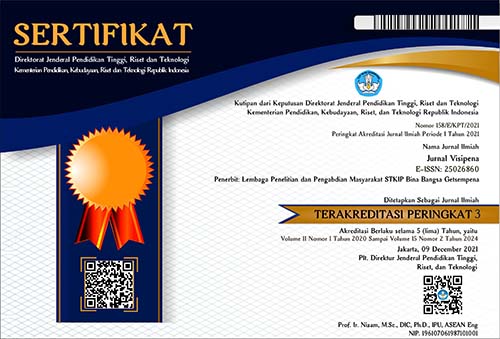STUDENT QUESTIONNAIRE OF PISA 2006 AND RASCH ANALYSIS
Abstract
PISA is one of the biggest international student assessments. The results of this study are frequently used to inform policy directions and to provide feedback to learning and teaching. However, due to country socioeconomic, cultural and language differences among the countries, the test instruments may not be funtioning in the same way in all culture. Those differences may cause non-equivalence of tests or or tests may not be fair among different cultures, which then challenges assumptions made about measurement equivalence. This study aims to examine the equivalence of motivation and self concept items on student questionnaires of PISA 2006 study whether fit Indonesia context or not. The study employed two analisis of Rasch model to seek the equivalence of the tests. The results revealed that there is no significant DIF on motivation scale. One important finding of DIF analysis using Indonesia data was that two items of self-concept scale have been shown favoring males. The study also found that all items on motivation and self concept scale fit the data set and are not dependent on upon the sample of Indonesian students. The test is fair among different groups and contexts. This study suggests that more scales analysis is required as it will provide more comprehensive findings about the equivalence of this survey test.
Downloads
References
Alagumalai, S. & Curtis, D. D. (2005).Classical Test Theory. In S. Alagumalai, D. D. Curtis, & N. Hungi (Eds.), Applied Rasch Measurement: A Book of Exemplars (pp. 1-14). The Netherlands: Springer.
Andrich, D. (1978). A rating formulation for ordered response categories.Psychometrika, 43(4), 561-573.
Ben, F (2010), Students’ uptake of Physics: A study of South Australian and Filipino physics students. Unpublished Doctoral Dissertation.The University of Adelaide.
Byrne, B. M. (2003). Testing for equivalent self-concept measurement across culture. In H. W. Marsh, R. G.
Craven, & D. M. McInerney (Eds.), Internationaladvances in self-research: Speaking to the future (pp. 291–314). Greenwich: Information Age Publishing.
Curtis, D. D. (2004). Comparing classical and contemporary analyses and Rasch measurement. In S. Alagumalai,
D. D. Curtis, & N. Hungi (Eds.), Applied Rasch Measurement: A Book of Exemplars – Papers in honour of John P. Keeves (pp. 181-197). The Netherlands: Springer.
Darmawan, I. G. N. (2005). Creating a scale as a general measure of satisfaction for information and communication technology user. In S. Alagumalai, D. D. Curtis, & N. Hungi (Eds.), Applied Rasch Measurement: A Book of Exemplars – Papers in honour of John P. Keeves (pp. 271-286). The Netherlands: Springer.
Darmawan, I. G. N. (2003).Implementation of Information Technology in Local Government in Bali, Indonesia.Adelaide, South Australia: Shannon Research Press.
Green, K. E. (1996). Applications of the Rasch model to evaluation of survey data quality. New Directions for Evaluation, 70, 81-92.
Grisay, A., de Jong J., Gebhart, E., Berezner, A., &Halleux-Monseur, B. (2006, April).Translation equivalence across PISA countries. Paper presented in the meeting of the American Educational.
Hauger, J. B., &Sirecy, S. G. (2008). Detecting differential item functioning across examinees tested in their dominant language and examinees tested in a second language. International Journal of Testing, 8, 237-250.
Linacre, J. M., Wright, B. D., Gustafsson, J-E & Martin-Lof, P. (1994).Reasonable mean-square fit values.Rasch Measurement Transactions, 8(3), 370.
Ludlow, L. H., & Haley, S. M. (1995).Rasch model logits: Interpretation, use, and transformation. Educational and Psychological Measurement, 55: 967–975.
OECD.(2006a). PISA 2006. Science Competencies for Tomorrow’s World. Volume 1 Analysis.Viewed on 5 Oct 2010.< 0,333,en_32252351_32236191_39718850_1_1_1_1,00.html.>
OECD.(2006b). Assessing Scientific, Reading, and Mathematical literacy.A framework for PISA 2006.Viewed on5 Oct 2010.
< http:www.pisa.oecd.org/dataoecd/63/35/37464175.pdf>
OECD (2009).PISA 2006 Technical Report.Viewed on 15 October 2010.
<http://www.pisa.oecd.org/dataoecd/0/47/42025182.pdf>
Raczec, A. E., Ware, J. E., Bjorner, J. B., Gandek, B., Haley, S. M., & et al., (1998). Comparison of Rasch and summated rating scale s constructed from SF-36 phisical function items in seven countries: Result from the IQOLA project. J ClinEpidemiol, 51(11), 1203-1214.
Rasch, G. (1960). Probabilistic models for some intelligence and attainment tests. Copenhagen, Chicago: Danmarks Pegagogiske Institut, University of Chicago Press.
Schibeci, R. A., & Riley, J. P. (1986). Influence of student background and perceiption on science attitude and achievement. Journal of Research in Science Teaching, 23 (3), 177-187.
Schulz, W., &Fraillon, J. (2009).The analysis of measurement equivalence in international studies using the Rasch model.Paper presented to the symposium on "Rasch measurement: present, past and future" at the European Conference on Educational Research (ECER) in Vienna, 28-30 September 2009.
Tilahun M. A. (2004). Monitoring mathematics achievement over time: a secondary analysis of FIMS, SIMS and TIMS: a Rasch analysis. In S. Alagumalai, D. D. Curtis, & N. Hungi (Eds.), Applied Rasch Measurement: A Book of Exemplars – Papers in honour of John P. Keeves (pp. 63-79). The Netherlands: Springer.
Wright, B. D. & Stone, M. H. (1999).Measurement Essentials (2nd ed.). Wilmington, Delaware: Wide Range, Inc.
Wright, B. D. (1997). Solving measurement problems with the Rasch model.Journal Educational Measurement, 14(2): 97–116.
Wright, B. D., & Linacre, J. M. (1994).Reasonable mean-square fit values.Rasch Measurement Transactions, 8(3), 370.
Wu, M. L., Adams, R. J., Wilson, M. R. & Haldane, S. A. (2007).ConQuest Version 2.0 [Generalised Item Response Modeling Software]. Camberwell, Victoria: ACER Press.
Yate, S. M. (2005). Rasch and attitude scales: Explanatory style. In S. Alagumalai, D. D. Curtis, & N. Hungi (Eds.), Applied Rasch Measurement: A Book of Exemplars – Papers in honour of John P. Keeves (pp. 207-226). The Netherlands: Springer.
Yildrim, H.H. (2006). The differential item functioning (DIF) analysis of mathematic items in the international assessment programs.Phd. Thesis.Middle East Technical University.




















